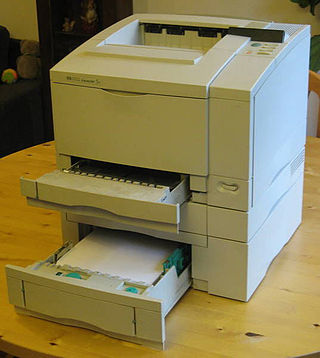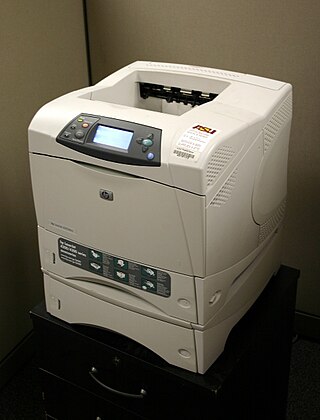
In computing, a printer is a peripheral machine which makes a durable representation of graphics or text, usually on paper. While most output is human-readable, bar code printers are an example of an expanded use for printers. Different types of printers include 3D printers, inkjet printers, laser printers, and thermal printers.

PostScript is a page description language and dynamically typed, stack-based programming language. It is most commonly used in the electronic publishing and desktop publishing realm, but as a Turing complete programming language, it can be used for many other purposes as well. PostScript was created at Adobe Systems by John Warnock, Charles Geschke, Doug Brotz, Ed Taft and Bill Paxton from 1982 to 1984. The most recent version, PostScript 3, was released in 1997.

Laser printing is an electrostatic digital printing process. It produces high-quality text and graphics by repeatedly passing a laser beam back and forth over a negatively charged cylinder called a "drum" to define a differentially charged image. The drum then selectively collects electrically charged powdered ink (toner), and transfers the image to paper, which is then heated to permanently fuse the text, imagery, or both, to the paper. As with digital photocopiers, laser printers employ a xerographic printing process. Laser printing differs from traditional xerography as implemented in analog photocopiers in that in the latter, the image is formed by reflecting light off an existing document onto the exposed drum.
A page printer is a computer printer which processes and prints a whole page at a time, as opposed to printers which print one line or character at a time such as line printers and dot-matrix printers. Page printers are often all incorrectly termed “laser printers”—although virtually all laser printers are page printers, other page printing technologies also exist.
HP-GL, short for Hewlett-Packard Graphics Language and often written as HPGL, is a printer control language created by Hewlett-Packard (HP). HP-GL was the primary printer control language used by HP plotters. It was introduced with the plotter HP-9872 in 1977 and became a standard for almost all plotters. Hewlett-Packard's printers also usually support HP-GL/2 in addition to PCL.

Typesetting is the composition of text for publication, display, or distribution by means of arranging physical type in mechanical systems or glyphs in digital systems representing characters. Stored types are retrieved and ordered according to a language's orthography for visual display. Typesetting requires one or more fonts. One significant effect of typesetting was that authorship of works could be spotted more easily, making it difficult for copiers who have not gained permission.

CUPS is a modular printing system for Unix-like computer operating systems which allows a computer to act as a print server. A computer running CUPS is a host that can accept print jobs from client computers, process them, and send them to the appropriate printer.
In computers, a printer driver or a print processor is a piece of software on a computer that converts the data to be printed to a format that a printer can understand. The purpose of printer drivers is to allow applications to do printing without being aware of the technical details of each printer model.
Printer Command Language, more commonly referred to as PCL, is a page description language (PDL) developed by Hewlett-Packard as a printer protocol and has become a de facto industry standard. Originally developed for early inkjet printers in 1984, PCL has been released in varying levels for thermal, matrix, and page printers. HP-GL/2 and PJL are supported by later versions of PCL.
An image file format is a file format for a digital image. There are many formats that can be used, such as JPEG, PNG, and GIF. Most formats up until 2022 were for storing 2D images, not 3D ones. The data stored in an image file format may be compressed or uncompressed. If the data is compressed, it may be done so using lossy compression or lossless compression. For graphic design applications, vector formats are often used. Some image file formats support transparency.
Open XML Paper Specification is an open specification for a page description language and a fixed-document format. Microsoft developed it as the XML Paper Specification (XPS). In June 2009, Ecma International adopted it as international standard ECMA-388.
Intelligent Printer Data Stream (IPDS) is Info Print Solution Company's Systems Application Architecture host-to-printer data stream for Advanced Function Presentation subsystems. It provides an attachment-independent interface for controlling and managing all point addressable (APA) printers that allow the presentation of pages containing an architecturally unlimited mixture of different data types, including text, image, graphics, bar code, and object container. It is used by a variety of Info Print and OEM print servers that drive all points addressable (APA) page printers. Generally, these printers are at the medium to the high end of the print speed and volume spectrum.
UniDrv is a GDI-based Microsoft Windows universal printer driver and architecture for non-PostScript printers. It is used to simplify driver development of non-PostScript printers for printer manufacturers. Unidrv allows the creation of a printer-specific minidriver in the form of a GPD file, similar to a PPD file, which is much simpler than kernel mode driver development. Unidrv was introduced in Windows 2000 and replaced the Raster Device Driver (RASDD) interface used in Windows NT 4.0 and earlier versions.
Personal Printer Data Stream is a general name for a family of page description language used by IBM printers, which includes all Proprinter, Quietwriter, Quickwriter, LaserPrinter 4019, and LaserPrinter 4029 commands.

Foomatic is a configurable printing filter. It uses PPD files as configuration to generate appropriate output for a given printer. It is spooler independent which means it can be used with Common Unix Printing System (CUPS), LPRng and others. It uses Ghostscript in the background, using options according to the PPD file of the printer. Currently it is developed by the OpenPrinting workgroup of the Linux Foundation.
ESC/P, short for Epson Standard Code for Printers and sometimes styled Escape/P, is a printer control language developed by Epson to control computer printers. It was mainly used in dot matrix printers and some inkjet printers, and is still widely used in many receipt thermal printers. During the era of dot matrix printers, it was also used by other manufacturers, sometimes in modified form. At the time, it was a popular mechanism to add formatting to printed text, and was widely supported in software.
PPML is an XML-based industry standard printer language for variable data printing defined by PODi. The industry-wide consortium of 13 companies was initially formed to create PPML, and now has more than 400 member companies.
The Hewlett-Packard Raster Transfer Language is a subset of the Printer Command Language (PCL) language. It is used to embed true raster images (bitmaps) into plotter files. Modern plotters are raster devices, so they need a raster-based language. For backward compatibility they also support the HP-GL/2 vector language, so the HP RTL language is designed for mixing with the HP-GL/2 language.
"Harlequin (software)" is a raster image processor first released in 1990 under the name ScriptWorks running as a command-line application to render PostScript language files under Unix. It was developed by Harlequin, a software company based in Cambridge, England.
Xerox Escape Sequence or XES is a page description language (PDL) developed by Xerox corporation and introduced with their 2700 laser printers in 1982. XES offers similar capabilities to Hewlett-Packard's Printer Command Language (PCL), which first appeared in 1984. XES is supported by most Xerox laser printers including the 2700. 3700, 4011, 4030, 4045, 4197, 4213, 4235, and 4700.





